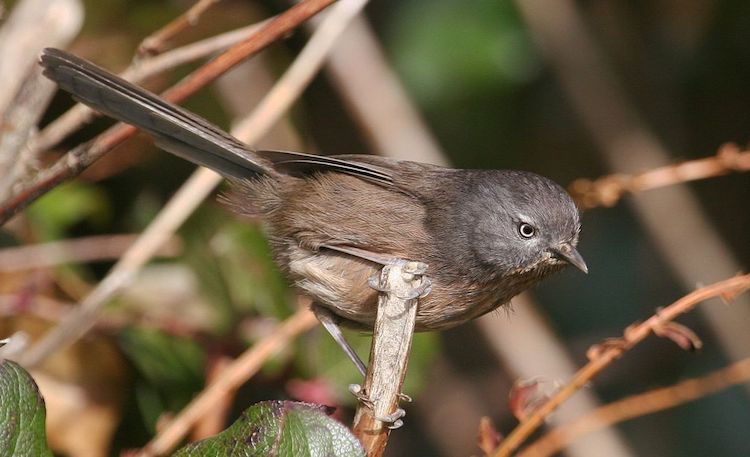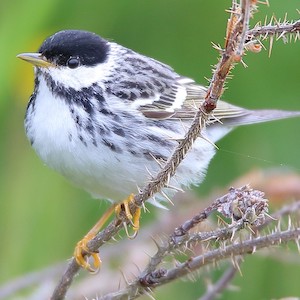While motorized off-highway vehicle (OHV) use is an increasingly popular way for humans to enjoy the outdoors, it seems like a given that birds do not enjoy this activity. In a new study published in Avian Conservation and Ecology, IBP scientists worked with the National Audubon Society and California State Parks to see what information about the effect of OHVs on birds could be gleaned from state-mandated monitoring data. The results were surprising. Contrary to expectations, some species of birds in the Hollister Hills State Vehicle Recreation Area appeared not to be negatively affected by OHV use. A few species even seemed to be more abundant in areas with more OHV trails. So what does this study really tell us about the effect of OHVs on birds?
First, it's useful to know a bit about the data and how they were analyzed. The dataset consisted of point counts done by volunteers and park staff as part of the Off-Highway Motor Vehicle Division's mandatory wildlife monitoring program. These data are valuable, but limited. As with any point count data, detection is imperfect. Birds can be stealthy, and an observer likely doesn't see or hear at least some of the birds within the count radius. In addition, birds were counted at each point only a few times– once in the spring (over two springs) and once in the winter (over three winters.) The challenge for the scientists was to find a statistical analysis method that would extract the most useful information from the available data.
The researchers chose to use a hierarchical community distance sampling (HCDS) model. These models are relatively new and mathematically complex, but they are well-suited to analyzing sparse datasets like this one. In addition, they also assess groups or communities of species rather than individual species. "Measuring the community response gives us one number that describes on average whether birds within a community are positively or negatively affected by something like OHV use," says Jerry Cole, a biologist with The Institute for Bird Populations and lead author of the paper. And since land managers are typically charged with managing multiple species simultaneously, these models can provide information that may be more useful to them.
But the models yielded surprising results. "Much of the research on OHV effects on birds to date shows that birds are negatively impacted by OHVs, with declines in abundance and reproductive success in OHV use areas," says Dr. Nicole Michel, a senior quantitative ecologist with the National Audubon Society and a co-author of the paper. "Based on this, we had expected to find lower bird abundance in areas with extensive OHV trails, and were initially surprised by the discovery of neutral, and even positive, responses."
During the winter, some common species, such as Bewick's Wrens, Wrentits and California Thrashers seemed to be more abundant in areas of the park used by OHVs. And these three, along with 5 other species, were more abundant in areas with a higher OHV trail cover. (The researchers used OHV trail cover, calculated as the area covered by OHV riding trails within a 100 m radius of the sampling point, as a proxy for intensity of OHV use.) In the spring, only the Wrentit had significantly higher abundance in OHV use areas, but 7 species had higher abundance in areas with greater OHV trail cover. There were no significant negative effects on abundance of OHV use or trail cover for any of the species analyzed during either season.
Why might birds be more abundant around OHV trails? The noise and other disturbance caused by OHVs could deter some predators, giving birds that can tolerate disturbance a safer space. Also trail cover is an imperfect approximation of trail use. Lots of trails does not necessarily mean lots of use. "It would have been great to use the number of OHV users passing a sampling point during the breeding season but that information was not available," says Cole. But trail cover is a good approximation of edge habitat, and many bird species may be attracted to edges where insects and seeds are sometimes more abundant.
Cole and colleagues say these results come with several large caveats. First, this is a case study of one, well-managed OHV park, where rules about staying on trails are well enforced. Studies in areas where OHV use is not well regulated have shown negative effects on birds. Second, the point count surveys started decades after OHV use in the park began, so populations of species that are sensitive to OHV use may have declined, or even disappeared, before the study began.
Lastly, these surveys looked only at abundance of birds, not their survival or reproduction. Sometimes habitats that are attractive to birds, because of food resources for instance, can actually be detrimental to them because of higher predation or nest failure rates. Indeed, a separate analysis showed that in the spring, birds were less diverse in areas used by OHVs than in unused areas of the park, suggesting that many species of birds may be less tolerant of OHV disturbance during the breeding season. "We really need more years of surveys, or better yet demographic studies (such as measures of reproductive success in OHV use and non-use areas) to be confident of our evaluation of OHV effects," says Michel.
Still, these results are good news for land managers trying to balance the interests of outdoor recreation and wildlife. The study shows that OHV use is not always incompatible with bird use. "In this well-regulated OHV park, some bird species can continue to persist in areas used by OHVs and areas with high OHV trail cover– but not all bird species," concludes Cole. "While OHV areas are not particularly ideal areas for birds, they are likely better than complete loss of habitat to development."






